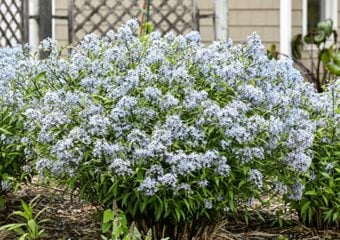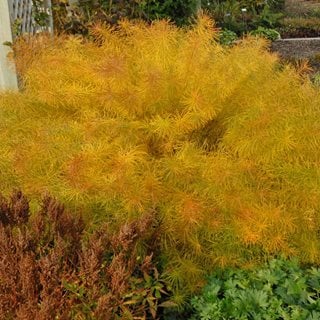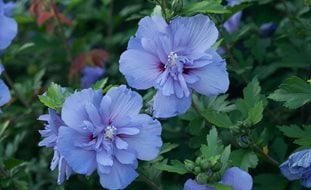How to Grow & Care For Amsonia (Blue Star)
This beautiful native perennial is prized for its true blue flowers and spectacular fall color.There aren’t many perennials that are valued as much for their late-season interest as they are for their showy spring flowers, but Amsonia (blue star) is among the few belonging to that distinguished group.
In late spring, blue star puts on a striking display of star-shaped blue blossoms, perched above handsome mounds of deep green foliage. But the real show begins in fall, when the whole plant lights up the garden by turning a brilliant, rich golden yellow.
Like many native plants, this sturdy perennial is also easy to grow, low maintenance, and trouble-free. Pests rarely bother blue star, and its inherent drought resistance keeps it looking attractive even where summers tend to be hot and dry.
2024 Landscape Perennial of the Year:
'Storm Cloud' bluestar amsonia.
On this page: Basics | Planting | Care | Varieties | Design Ideas
- BASICS
- HOW TO PLANT AMSONIA
- AMSONIA PLANT CARE
- AMSONIA VARIETIES
- DESIGN IDEAS FOR USING AMSONIA PLANTS
BASICS
Botanical name:
Amsonia spp. and hybrids
Common names:
Threadleaf blue star, Arkansas blue star, Hubricht’s blue star, eastern blue star, blue dogbane
Plant type:
Herbaceous perennial
Zones:
Typically 4-9, but can vary by species
Exposure:
Full sun to partial shade
Growth habit:
Upright and shrub-like
Height/spread:
1 to 3 feet tall, 2 to 3 feet wide
Bloom time:
Late spring to early summer, with blooms lasting 3 to 4 weeks
Foliage:
May be slender and needle-like or lance-shaped, depending on the species. Remains dark green for most of the growing season, turning shades of golden yellow in October.
Flowers:
Five-petaled blossoms, measuring 3/4-inch across, range in color from pale powder blue to deep lavender blue. Narrow, bean-like seedpods will often form after flowering and can offer additional interest.
Special attributes:
- Deer resistant
- Drought tolerant
- Attracts bees, butterflies, and hummingbirds
- Requires minimal pruning
Is amsonia invasive?
Although blue star is a clump-forming perennial, it won’t become invasive and grow out of bounds. The clumps spread very slowly over time and are easily divided.
Is amsonia poisonous?
A member of the dogbane or milkweed family (Apocynaceae), Amsonia produces a mildly toxic latex sap that makes it unpalatable to deer, rabbits, and other garden pests. Although not considered to be poisonous to people or pets, the sap can be a skin irritant. Be sure to wear gloves when pruning plants to prevent contact.
PLANTING AMSONIA
When to plant:
In spring, after the threat of frost has passed, or in early fall.
Where to plant:
Although blue star can tolerate light shade, a location with full sun will ensure the best flowering and fall foliage color. Plants tend to flop open when grown in too much shade.
How to plant:
Dig a hole twice the size of the root ball and amend the soil with a handful of compost. Place the plant in the hole so the crown is level with the surrounding soil and then backfill. Tamp down the soil gently to remove air pockets, and water thoroughly. Although you can also grow amsonia from seed, it is much easier to grow plants from nursery starts, since germination can be slow and unpredictable.
Soil:
Prefers average, moist, well-drained soil, but will adapt to most soil types (including clay and sandy soils) as long as plants aren’t allowed to dry out completely. Avoid growing in highly fertile soil, which can cause weak, floppy growth.
Spacing:
2 to 3 feet apart, depending on width at maturity
Growing in containers:
You can also grow blue star in containers on patios and balconies as long as the pot is large enough to accommodate the plant’s deep taproot system. A 10- to 15-gallon pot with plenty of holes at the bottom for good drainage is ideal. Remember that plants grown in pots will require more water and fertilizer than their in-ground counterparts, so consider using a self-watering container or installing an automatic drip watering system. Get more tips for growing plants in containers.
Video by Walters Gardens / Proven Winners.
AMSONIA CARE
Watering:
Water plants regularly until they become established, providing about 1 to 2 inches of water per week during their first year in the garden. Once it reaches maturity, Amsonia is drought resistant due to its deep taproot system and will only need to be watered during dry spells and periods of extreme summer heat. Be careful not to overwater. Root rot can occur if you allow your plants to sit in soggy soil.
Amendments and fertilizer:
Amsonia prefers lean conditions, needing little or no supplemental fertilization. Generally, applying a thin layer of organic compost around the base of your plants in the spring is sufficient.
Pruning and deadheading:
When grown in some shade and or in rich soils, Amsonia tends to sprawl and may require staking or pruning. For a neater appearance, consider cutting plants back by a third or half in late spring to encourage bushier growth and a more rounded habit. At the end of the season, the stems can be cut close to the ground or left standing for winter interest. Deadheading of amsonia is rarely necessary, unless you want to prevent self-seeding.
Dividing:
To divide, dig up the plant and separate the clumps into well-rooted sections using a spade or garden knife. Replant the divided sections in new locations or containers.
Propagation:
Can be propagated by seed or division.
Overwintering:
Although Amsonia is cold hardy, it will benefit from mulching in areas with harsh winters. In late fall, apply a thick layer of compost, leaves, straw or other organic material over the crown of each plant to help prevent damage during severe cold snaps.
Plants growing in containers can be moved into an unheated, protected area before temperatures plunge (such as a shed or garage) or you can insulate the roots by wrapping the pots in burlap or old blankets. In warmer climates with only brief periods of freezing temperatures, you can leave your containers in place.
Pests and diseases:
Virtually unaffected by insects, diseases, and animal pests, blue star is one plant in the garden that you won’t have to keep a close eye on.
AMSONIA VARIETIES
DESIGN IDEAS FOR USING AMSONIA PLANTS
Amsonia is a versatile perennial with many uses in the landscape. Here are a few ideas for taking advantage of its best attributes:
- Creating a charming blue-themed cottage garden by planting amsonia alongside other sun-loving blue flowers, such as delphinium, Virginia bluebells, and love-in-a-mist.
- Naturalize with other native plants in a meadow garden, such as black-eyed Susan, coneflower, and switchgrass.
- Because blue star plants are so full and upright, you can use them alone, in mass plantings, or even as a semi-formal hedge or edging plant.
- Mass along the lightly shaded borders of a woodland garden, planting shade-loving plants such as hostas, ferns, and bleeding hearts in the background.
- Use as a backdrop in the fall garden, where the warm golden-yellow foliage will enhance the beauty of mums, asters, sedums, and other traditional fall bloomers.











